All screencaps are courtesy of Animationscreencaps.com (formerly Disneyscreencaps.com)
I’ve been wanting to make this post for months now, but I had to wait until I’d completed all of the film reviews. Through the years, Disney have used a wide range of historical settings as the inspirations for their films, and anyone who’s been reading the blog for a while will know that I’m a huge history nerd (by the way, I must apologise for how out of control those “Year in History” boxes got in the end). Recently, we’ve been seeing a lot of Disney fans putting some serious thought into just where and when these films could be taking place, with creators like Aish of Disney’s New Groove and GeekDad making elaborate timelines to put them all into date order, and DeviantArt creators like Wickfield and Shoomlah designing fantastic historically-accurate re-imaginings of some of the characters. I looked to all of these and more for inspiration for my own timeline, and I’ve honestly had such a great time learning more about the times these characters may have lived in, had they really existed.
Of course, while this is a fun experiment for Disney fans who love history, it can also be an exercise in frustration. Disney aren’t known for being bastions of historical accuracy, and many of the films – particularly the princess ones – are overflowing with anachronisms, making it clear that the filmmakers were more interested in choosing the more familiar or appealing aesthetics than the correct ones. The time periods of some of the older-set films are nearly impossible to nail down because of this but I’ve done my best with the clues we’re given, so wherever I give a date with “c.” before it (circa), I’m indicating that it’s only a rough guess.
In some films an exact time and place are made explicit for us (which makes things a lot easier for me), but for others I looked for any clues in the fashions, the architecture, the language and anything else to try to work out where and when we are supposed to be. In films with a lot of anachronisms, I tried to pick a period that would have had the majority of the elements presented, and sometimes I’ll look to the dates of the source material for help, too. It’s a real minefield! So, here we go – all fifty six canon films, rounded out with a few package film segments and one Pixar film. Let’s take a Disneyfied walk through history, beginning eons ago at the dawn of life on Earth…
1. Fantasia (Rite of Spring)
Date: Precambrian Era to Mesozoic Era (4,600 MYA to 66 MYA)
Place: North America (then part of Pangea)
This is one of only two times that a Disney film has depicted the age of the dinosaurs, but this short takes the edge as the oldest setting of any Disney film for depicting the beginning of the planet itself. Starting in the Hadean Eon, we witness the dawn of life and the rise of the dinosaurs in the Mesozoic, with the latter period taking up most of the short. Granted, there’s a fight between a Stegosaurus and a Tyrannosaurus – two species further apart in time than we are from the T-rex – but what the heck, it’s a cool moment.
2. Dinosaur
Date: Cretaceous Era (c. 150 MYA?)
Place: North America (then part of Laurasia)
This has the distinction of having the oldest setting of any full-length film in the canon by hundreds of millions of years. What sets it apart from many other mainstream dinosaur films is that it features a lot of lesser-known species in place of the more iconic ones – however, not all of them lived in the same time or place. Baylene is the most glaring anachronism, a Jurassic-era brachiosaurus amongst Cretaceous creatures, while iguanodons were from earlier in the Cretaceous than most of the other species featured. The herd animals, at least, are all from about the right time and place (what is today North America), but the velociraptors and oviraptors belong in Asia, the carnotaurs should be in South America (“They never come this far north!” Yeah, no kidding), and then there are the Eocene Era lemurs…
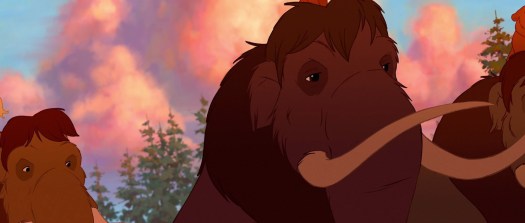
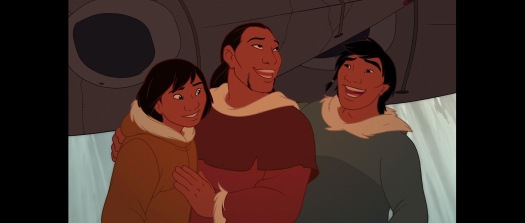
3. Brother Bear
Date: Neolithic, c. 10,000 BCE
Place: Alaska/Canada
With this film, the directors were specifically trying to avoid causing any controversy with their depiction of Native Americans, so they set it thousands of years in the past during the last Ice Age to make it clear that the people onscreen did not belong to any modern culture. At best, Kenai and his people could perhaps be described as ancient Iñupiat, but you can’t get any more specific than that. The presence of mammoths is, of course, all we need to know how long ago this is. Some people have suggested the film could actually be set in Canada due to the accents of the moose, but they could just be immigrants or something – the filmmakers were very clear about the Alaskan setting.
4. Atlantis: The Lost Empire (prologue)
Date: Neolithic, c. 6,400 BCE (or 1,650 BCE)
Place: Atlantis (Mediterranean/Santorini – then known as Thera)
I relied on the Atlantis Wiki for this one; it gives Kida’s precise date of birth as 6,586 BCE, so I’ve chosen a date slightly later than this to allow her a few years of growing time. As for the location, the debate about where exactly the fabled land of Atlantis is supposed to be has been going on for millennia, but the most reliable arguments equate it with the Greek island of Thera (now Santorini), which was devastated by a cataclysmic volcanic eruption around 1,650 BCE. The eruption has been described as a possible inspiration for the legend of the destruction of the city, so I’ve also included that date as a possibility.
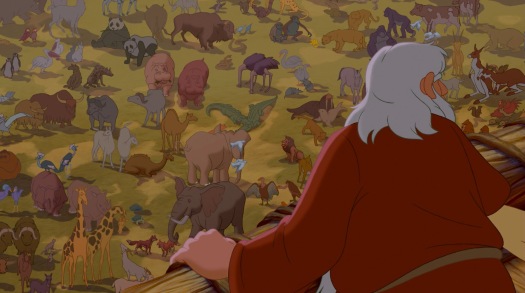
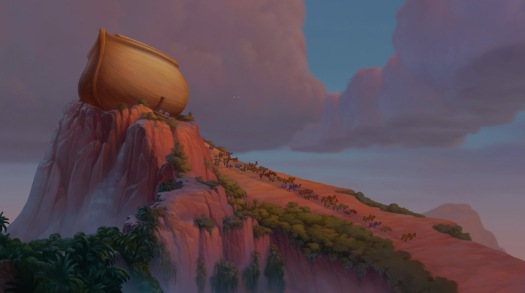
5. Fantasia 2000 (Pomp and Circumstance)
Date: c. 2,348 BCE
Place: Mount Ararat, Turkey (then, as now, part of Anatolia)
I don’t want to step on any toes here, so I’m not getting into a debate about whether or not the events in the Bible actually happened. Suffice it to say that, if they did, the best evidence for the date of the Genesis Flood puts it around this time. The location, at least, is less debatable – Noah’s Ark is said to have come to rest atop Mount Ararat, at the border of modern-day Turkey. All I can wonder now is how damn old Donald Duck really is…
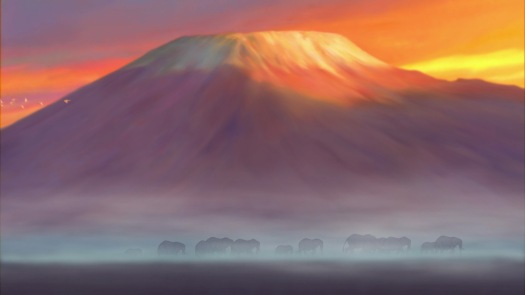
6. The Lion King
Date: c. 429 BCE?
Place: Kenya/Tanzania
This film is a bit of a historical enigma, because there’s absolutely no trace of human culture anywhere in it at all. No human villages, no fires or domesticated animals, no jet contrails or jeeps full of tourists on safari… Due to this, you can reasonably claim just about any time period for the setting, although it’s likely a pre-industrial time at the very least. Personally, I decided to use that little “cameo” from Hercules as my only clue – we see Hercules briefly wearing a lion pelt resembling Scar, making the only link between this film and human history. It’s semi-plausible that his skin could have been found by wandering tribesmen (although how they got it away from the hyenas intact is anyone’s guess), who then traded it to the Nubians, who traded it to the Ancient Egyptians, who traded it to the Ancient Greeks… right?
7. Hercules
Date: c. 429 BCE
Place: Thebes, Ancient Greece
For this one, I’m using the date of the first performance of the play Oedipus (Rex), which Hercules and Meg mention having seen at one point. Although the myths of Herakles generally put his life in the thirteenth century BCE (a good eight hundred years further back), I don’t think this particular film version is set then. Following the collapse of Athenian power after the Peloponnesian War (431-404 BCE), Thebes rose to prominence and became a powerful state for a while before being eclipsed by Macedon. The original Herakles was also said to have been one of Jason’s Argonauts during the Trojan War, but in this version, that event seems to have happened long ago, as Phil has the “mast of the Argo” in his artefact collection. Either way, the clothing is about right for the time – Meg is in a more fitted version of a Doric chiton, while Hercules wears a muscle cuirass over a tunic in the style of a hoplite soldier.
8. The Black Cauldron
Date: c. 500s CE
Place: Prydain (mythologised Wales?)
Given this film’s turbulent production history, it’s safe to assume the filmmakers weren’t really concerned with accuracy in depicting the Early Middle Ages. Taran’s tunic and hose are about right, at least, and wandering minstrels like Fflewddur Fflam were indeed popular throughout medieval times. Then again, Eilonwy’s dress would look more at home about a millennium later in time…
9. Mulan
Date: c. 500s-600s CE
Place: Near Beijing, northern China
Oh, here we go. I adore this film, but trying to pinpoint its historical setting was an absolute nightmare. Anachronisms abound and it was an incredible struggle to choose a dynasty, but after consulting as many sources as I could I’ve decided to go with the Sui Dynasty. I know that in my film review I tentatively settled on the Han Dynasty (as have several other fans attempting this), mainly because of the Han-Xiongnu conflict and Modu Chanyu, but I made a blunder because that actually happened centuries before Mulan is supposed to have lived. The briefer Sui Dynasty (which ended in 618) came a little after the height of the Hunnic Empire and may have had fireworks, but it still lacked the Forbidden City (which dates from the 1400s and is thus completely out of place). Fashion-wise, Mulan does at least wear a roughly period-appropriate hanfu for the matchmaking ceremony, but the jointed lamellar armour worn by her, Shang and the others had probably been replaced with scale armour by that time. It’s really just a case of picking which details you want to pay attention to and which you don’t!
10. Aladdin
Date: c. 900s CE
Place: Agrabah, Iran (then known as Persia)
Another historical headache, here. Despite the “third century” quip from the Genie and the Arabian Nights song, several elements of the society of Agrabah seem to correspond with the Iranian Samanid Empire. The use of the word “Allah” suggests a Muslim society, the title of Sultan (rather than Shah) and the apparent absence of a higher caliphate suggests a post-800 setting, the architecture looks Persian and Jafar’s name implies a Shi’a presence in the area, all of which points to the time of the Samanid dynasty of sultans. Additionally, the presence of fireworks puts the film after the introduction of gunpowder, several centuries earlier.
Jasmine is wearing sirwal trousers and Turkish Çarık shoes, but her midriff-bearing top is… problematic. It may have been loosely based on the Indian choli, which is usually worn under a sari and was no doubt inspired by belly-dancing fashion (i.e. the bedlah), but real Persian women at the time would have been dressed much more modestly, especially the royalty, perhaps even wearing a head covering like a hijab. I don’t mean to sound rude, but Jasmine is basically dressed like a Persian prostitute! (We even see some actual prostitutes in One Jump Ahead wearing the same thing). At least she does cover up a bit when she goes out in public. Aladdin’s fez is also a bit out of place, more commonly seen in Morocco or Tunisia – perhaps it was a discarded import from the nearby Byzantine Empire.
11. Brave (Honorary Pixar inclusion)
Date: c. 900s CE
Place: Scotland (then the Kingdom of Alba)
I’m only including Brave because Merida is part of the official Disney Princess line-up, and also because it’s pretty much the only “period piece” Pixar have done to date. The directors have confirmed that it’s supposed to be tenth century Scotland, but the clothing is a bit patchy. Elinor’s surcote and kirtle are about right for the time, although both she and Merida would likely have worn veils over their hair (the wimple Merida has on at one point is far too modern). Some of Merida’s dresses look like they’ve been borrowed from the nineteenth century art of John William Waterhouse, and the Pictish body paint and sixteenth-century kilts on the men are further blunders included simply because they scream “Scottish”. The inclusion of bears has been criticised as inaccurate by some, but it’s probably not; the animals were first brought over to entertain circuses and may have still existed here as late as the tenth century, but they would have been on their last legs by then.
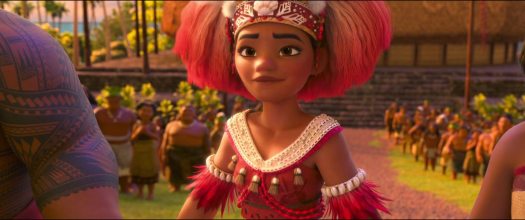
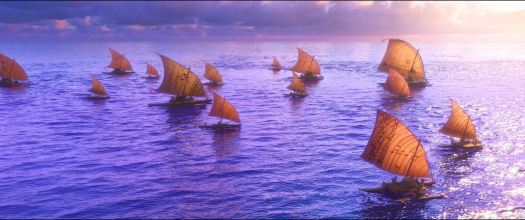
12. Moana
Date: c. 1000 CE
Place: Motonui (Samoa)
This one was another challenge, but as far as I can make out, this was the approximate time when the “Long Pause” in Polynesian voyaging came to an end, with a key part of the plot being Moana’s attempts to get voyaging started again. Expansion into the Pacific islands had begun thousands of years earlier before the pause, and Samoa (which is basically the real-life Motonui) had long been settled by 1000 CE. I consulted various sources before choosing this period, but most of them were infuriatingly vague with their dates – current research puts the final burst of Polynesian expansion between about 1000 and 1300, while the filmmakers have variously claimed the setting to be 2000 or 3000 years ago, so I don’t think anyone is quite sure!
13. Robin Hood
Date: c. 1194
Place: Nottingham, England
One of the characters in this film is based on a real historical figure, so that helped! King Richard the Lionheart did not actually spend a lot of time in England, too busy defending it abroad for much of his reign. After being held captive by Leopold V, Duke of Austria and Henry VI, Holy Roman Emperor, he was finally released in 1194 and returned briefly to England, so I chose this as the setting of the film (incidentally, the real Richard forgave his brother John for his transgressions). The fashions do more or less fit the period, with tunics, kirtles and veils, but Richard’s tabard is both too modern and too lower class for a king.
14. The Sword in the Stone
Date: c. 1200s CE
Place: Near London, England
The supposed period of the “real” Arthur’s youth was around the fifth century, but the style of stone castles and plate armour (not to mention the jousting tournaments) suggest a time closer to the 1200s; in White’s novel, the death of Uther Pendragon is in 1216. As with Aladdin, we can’t pay attention to anything Merlin says, because like the Genie he is able to travel through time on a whim and so has all sorts of anachronistic knowledge.

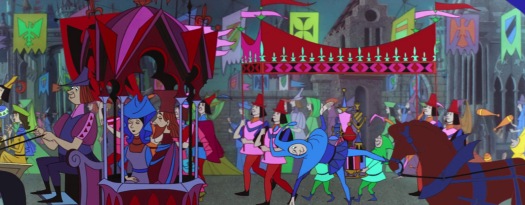
15. Sleeping Beauty
Date: c. 1450s
Place: France/Italy
First thing to do with this one is discard that line from Philip – “This is the fourteenth century!” This is probably just down to the writers making a common mistake; centuries are named after their last year rather than their first because there was no “Year Zero,” so it’s safe to assume the filmmakers were trying to refer to the 1400s (i.e. the fifteenth century). The fashions on the characters certainly suggest this more than the prior century; the women are in long gowns and hennins, with Maleficent sporting an amazing stylised sort of houppelande, and most of the men wear the standard tunics and hose (King Hubert is a bit of an anachronism, dressed in a Henry VIII-style doublet). Aurora’s long, loose, blonde hair would have been a popular look in sunny Italy – elsewhere in Europe (like in France), most Christian women would be expected to tie up and cover their hair with veils. Her peasant dress with its pleated skirt is very fifties, but her fancy gown is a bit better, featuring long tapering sleeves that half-cover her hands (not sure about those shoulders though).
16. The Hunchback of Notre Dame
Date: 1482
Place: Paris, France
The date for this story can be taken from the original novel, which is very specific about it. Nothing in the film seriously contradicts the 1482 setting, although France was not fighting any wars at the time so it’s anyone’s guess as to where Phoebus has been. Frollo’s robes and chaperon-style hat are typical for the period (although said hats were just going out of style at that point), and Esmeralda’s loose-fitting blouse and skirt is more or less accurate too, although the colour is a bit bright for a peasant and as a Romani woman, she would likely have worn it with a turban and cloak.
17. The Emperor’s New Groove
Date: c. 1500
Place: Peru (then the Incan Empire, or Tawantinsuyu)
Although this film takes a loose, Hercules kind of approach to its depiction of another civilisation, it can be safely assumed that this is set in Peru, which was the heart of the Incan Empire. It was at its height around this time, a few decades prior to the Spanish Conquests (which kicked off in the 1520s). The title of emperor wasn’t a thing, though – instead, the ruler was known as the Sapa Inca and in this particular year, the real-life one was Huayna Capac.
18. Snow White and the Seven Dwarfs
Date: c. 1550s
Place: Black Forest, Germany (then part of the Holy Roman Empire)
Given the association with the Brothers Grimm, it’s natural to place this film in Germany. If we want to be more specific, we can look to the carved furniture decorating the dwarfs’ cottage, which suggests a setting somewhere near the Black Forest region. Most other timelines use the presence of yodelling in the film to date it more precisely; the music style was first recorded in Europe in 1545, so the middle of the century seems about right. Snow White’s puffed sleeves and full skirt suit the period (although she really should have longer undersleeves like Rapunzel’s, too), and the high collar is vaguely appropriate, even if her wavy bob is pure 1930s. The prince and the queen are both dressed a bit too early for the time, though, with the queen in a medieval wimple and bliaut, but what can you do – the princess films are always a mishmash and this one fares better than the older-set ones.
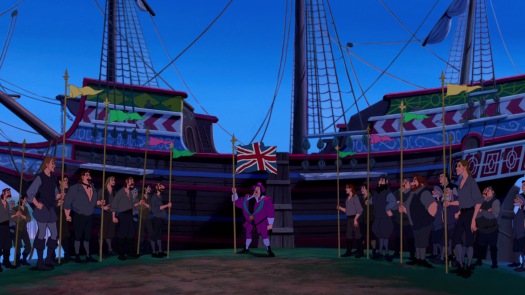
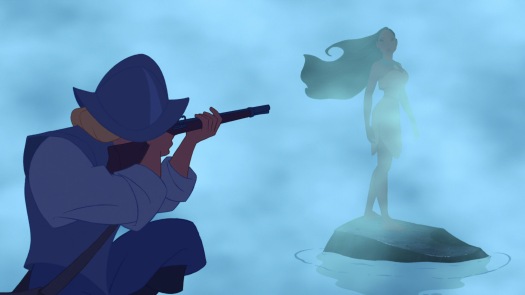
19. Pocahontas
Date: 1607
Place: Jamestown, Virginia, the “New World” (future USA)
Ah, yes, the infamous Pocahontas. Based on real history, it is explicit about both its time and its place, right down to the year and the town. Many details are right for 1607 – the matchlock muskets, the wooden ships (of which there were three in reality), the jerkins and breeches on the men and the court fashions in Ratcliffe’s fantasy, with ruffs and wide skirts. There was some acceptable artistic license taken with Pocahontas herself, because in reality she would have been topless and maybe even bald when Smith met her! However, I must correct an error I made in the film review; I claimed that the Union flag seen in the film is correct, but I’ve researched it more thoroughly and I now understand why it is, in fact, wrong. The flag introduced in 1606 lacked Saint Patrick’s Saltire as part of its design; this was only added to form the modern design in 1801, so unfortunately this is a blunder on the filmmakers’ part (but only a small one, to be fair). Sorry for the confusion! This film might have gotten a lot wrong, but at least it does represent the period fairly accurately.
20. Beauty and the Beast
Date: c. 1710s
Place: Loire region, France
The filmmakers were explicitly aiming for this century with the fashions (which were more accurate in the concept art – where are all the elaborate wigs and hairpieces?) and Cogsworth’s references to the neoclassical, Baroque and Rococo architectural styles suggest a date later than 1750, but it has to be pre-1789 (for obvious reasons). Belle’s ballgown should really have had sleeves instead of gloves, but the basic shape of it is correct with its fitted bodice and full skirt.
{MAJOR NOTE: I can hardly believe it, but Tom Sito himself – one of the original writers for this film – has pointed out that the correct date range for this film is in fact 1708-1720, with the setting being the Loire region. Many thanks to Mr. Sito for the correction!}
21. Tangled
Date: c. 1780s
Place: Germany (then part of the Holy Roman Empire)
Oh dear. This is another screwy one – the official word of the directors is that it’s 1780s Germany (roughly), but there’s much debate among fans due to the clashin’ fashions. Gothel’s, at least, is cleverly deliberate due to her unnatural age – she’s in a medieval bliaut, centuries out of fashion by this time – but everyone else is wearing stuff from all over the place. Rapunzel looks like a contemporary of Snow White’s and her outfit is actually more accurate for the sixteenth century than Snow’s was – cap sleeves over longer undersleeves, front-tie bodice and narrower skirt. In some ways, her outfit resembles the Bavarian dirndl, although it’s a bit early in time for one. Perhaps the simplest explanation for this discrepancy is that Rapunzel’s only knowledge of fashion would be coming from Gothel, so it makes sense that she’d be dressed a bit behind the times. Queen Arianna is dressed more appropriately for the 1780s, wearing a toned-down gown with the right silhouette, but her husband looks a few centuries out of date with his long overcoat and puffed sleeves, and the palace guards are cutting edges with their nineteenth century uniforms, featuring crossed-straps over the chests and shako hats.
At least the whole Mozart thing is right for the decade – he was at the height of his popularity then, right before his death. As for the Frozen cameo, I’m disregarding it; Disney characters make split-second cameos in each other’s films all the time, whether it makes sense or not. Belle appears briefly in Hunchback, despite being a good three hundred years out of place!
22. The Adventures of Ichabod and Mr. Toad (The Legend of Sleepy Hollow)
Date: c. 1790
Place: Sleepy Hollow, New York, USA
I got the date for this one from online trivia so I don’t know how reliable that is, but the fashions we see do align with the 1790s – panniers under the skirts, parasols, coonskin caps and frock coats, for instance. The rural context with the unpaved streets also fits (America didn’t start paving its streets until the late nineteenth century), and the real town of Sleepy Hollow did exist by then .
23. Melody Time (The Legend of Johnny Appleseed)
Date: c. 1806-1845
Place: American Midwest
Much like Pocahontas, “Johnny Appleseed” is actually based on the life of a real person, named John Chapman. The main portion of the short is dated specifically to 1806 when the real Chapman would have been about thirty-two, setting the film very specifically in time. 1806 was just after the Louisiana Purchase (1803), the Land Act of 1804 and the Lewis and Clark Expedition (which ended that year), all of which helped to instigate that first push out west as Americans eagerly sought to explore their new territories. Time progresses throughout the short and we witness Johnny’s death, which in reality was in 1845.
24. The Little Mermaid
Date: c. 1837?
Place: The US Virgin Islands (then the Danish West Indies)
Not again! The Little Mermaid is up there with Mulan and Aladdin as one of the biggest historical headaches in the entire canon; everybody else who’s attempted this timeline idea seems to have struggled to place it. The original story is Danish, but the setting of the film is blatantly tropical (trust me, the North Sea does not look like that even on a good day), so the only way to reconcile the two is by opting for the Danish West Indies (now the US Virgin Islands), which would also explain Sebastian’s Caribbean accent. As for the date… Yeesh. A lot of sources have suggested the 1890s, but somehow Eric’s kingdom doesn’t look industrial enough for this to be true. The wooden sailing vessels, Grimsby’s frock coat and Ariel’s hideous off-the-shoulder, gigot-sleeved dinner dress suggest an earlier time, so I went with the date of the original publication of the story, since the elements presented seemed to match it well enough.
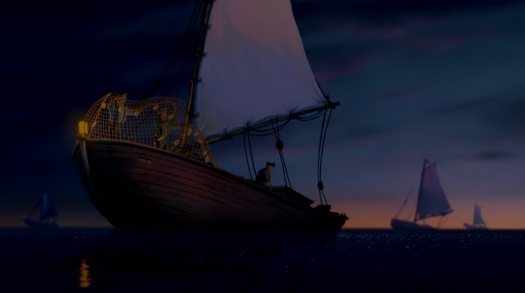

25. Fantasia 2000 (Piano Concerto No. 2)
Date: c. 1838
Place: Copenhagen, Denmark
Once again, for this one I went with the date of the original publication of the story. Toy soldiers and jack-in-the-boxes did exist by this time, and we don’t really see enough of the fashions on the people to contradict this setting.
26. Frozen
Date: c. 1840s
Place: Arendelle, Norway
This is another tricky one, but the directors have named this decade in particular as their primary influence – it’s officially supposed to be set around 1840. The native Norwegian clothing of the time (for both sexes) was called bunad, and hints of this style can be seen in some of the costumes here (more so on the citizens of Arendelle), while our heroines’ costumes make extensive use of rosemaling, a traditional form of decorative folk art which can also be seen elsewhere in the film’s design. Kristoff is also dressed appropriately in a gákti and a hat similar to the Four Winds hats worn by the Sámi. Of course, Elsa’s ice dress would look more at home on the red carpet than in the mid-nineteenth century; real gowns of the time generally had baggier sleeves, and they certainly wouldn’t have been so form fitting or had racy thigh splits. The designers obviously just decided to throw accuracy out the window for that one in favour of creating a more “marketable” dress for merchandising.
27. Melody Time (Pecos Bill)
Date: 1840s through the 1860s
Place: Pecos River, Texas, USA (just after the republic became a state)
A map is shown, which allows us to pin the location down to Texas (and Bill himself was named after the river). The character of Pecos Bill was supposed to have lived around this time, and the covered wagons, fashions (bustles) and the “wild west” setting all vaguely support it. There’s also a reference to the 1849 Gold Rush – which in this telling is down to Bill knocking the gold teeth out of some cattle rustlers! Mind you, Slue Foot Sue’s skirt in her first appearance is wildly inaccurate for the time; she’d have probably been arrested for wearing that in the mid-nineteenth century!
28. Alice in Wonderland
Date: 1865
Place: Southern England (and Wonderland)
Yet again, I’ve taken the date of the publication of the story. Alice’s full skirt and pinafore (and her sister’s summery bonnet) support an 1860s setting, and it’s really the only hint of human civilisation we get – the rest of the time is spent in Wonderland.
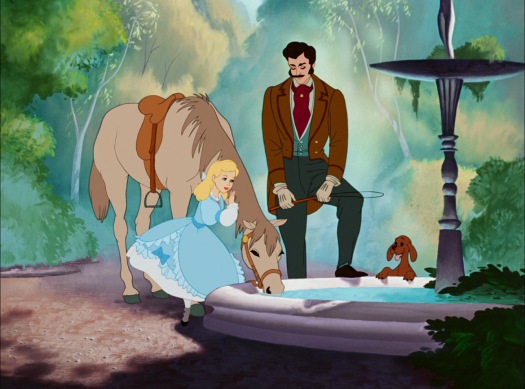
29. Cinderella (prologue)
Date: c. 1860s
Place: France
Young Cinderella is dressed similarly to Alice in the prologue with a very full-skirted dress, and her father’s sideburns and suit are also appropriate for the time. More importantly, an 1860s setting would also fit with the 1880s setting I’m proposing for the rest of the film – in that, Cinderella is officially nineteen years old, so two decades back would make her childhood about this time.
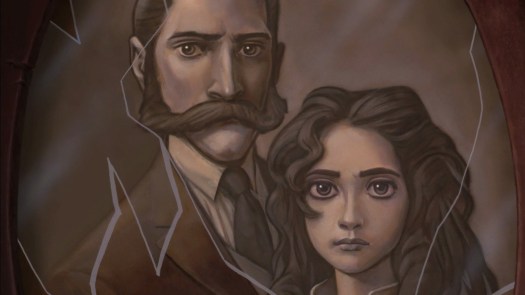
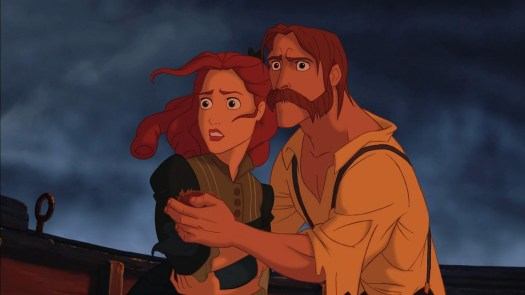
30. Tarzan (prologue)
Date: c. 1860s
Place: Nigeria (then British Nigeria)
Tarzan might not be a contemporary of Anna and Elsa, but he could be a contemporary of Cinderella’s! The prologue to his film shows his parents in 1860s fashions and hairstyles (look at those friendly mutton chops and sausage curls) and the wooden ship also matches the time, although sailing ships were on the way out by this point, being replaced by steamships (this process was sped up considerably once the Suez Canal opened in 1869, drastically cutting the distance to be travelled). The portrait of Tarzan’s parents also looks like a daguerreotype, the precursor to modern photographs, which peaked around this decade before being gradually superseded by less expensive processes.
For the setting, I originally thought the Congo was most likely due to it being the only place where rainforests would be in such close proximity to the coastline, but then I settled on Nigeria, because it was a British colony at the time and would thus have been easier for Jane and Porter to visit than the French and Belgian-controlled Congolese states. Nigeria does still have gorillas to this day, but there were doubtless many more of them back then.
31. Melody Time (Once Upon a Wintertime)
Date: c. 1860s
Place: New England, USA
Only in the 1860s would a girl wear a massive crinoline like that for ice skating. Jenny also wears a bonnet and sausage curls, and the double picture frame we see further suggests the Victorian Era.

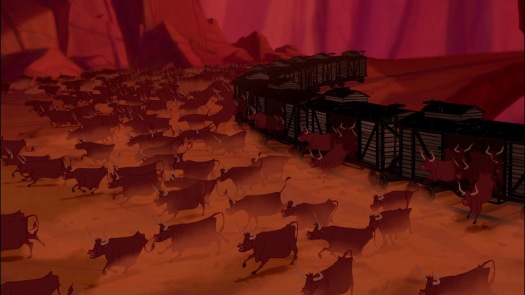
32. Home on the Range
Date: c. 1870 (UPDATE)
Place: Arizona/Texas, USA (then the Territory of Arizona)
This one bounced around a lot; it’s such a lazily done film that it’s actually pretty tough deciding when in the “old west” it’s taking place. I opted for about 1870 because cattle drives were peaking around that time, giving Slim plenty of opportunity fer rustlin’, but the date also had to be prior to the Chinese Exclusion Act of 1882 (seriously, what the heck), because we see a Chinese immigrant in one scene who appears not to have been in America long. The steam train and pilot (or “cowcatcher”) also look about right for the time, Pearl wears a long skirt and bonnet-like hat that are basically correct, and Slim wears chaps, which were becoming standard wear for cowboys around this decade.
UPDATE: I have been made aware that the date 1889 can be made out on Slim’s deed to Patch of Heaven, so this could be considered the “official” year. Of course, that clashes with the 1882 Chinese Exclusion Act detail, but I’m sure the writers were past caring about accuracy by the end of this thing.

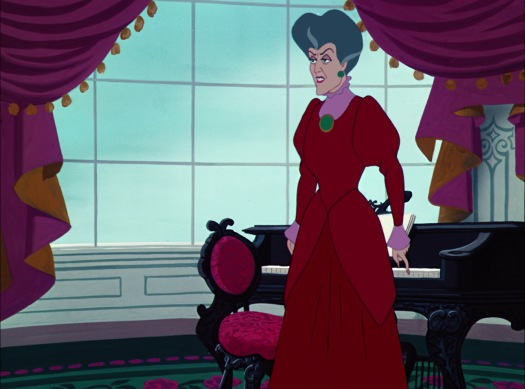
33. Cinderella
Date: c. 1880s
Place: France
Once again, we must look to fashion to guide us. Many timelines seem to suggest an earlier decade, but I thought the pronounced bustles, corsets and sausage curls worn by the stepsisters could only mean the 1880s. Lady Tremaine’s high-collared, puff-sleeved gown and upswept hair are rather more 1890s, but perhaps she’s just a trendsetter. Prince Charming wears the kind of generic military uniform typical of European aristocracy of the century. The palace may be electrically-lit, since the technology was spreading quickly through France by this decade.
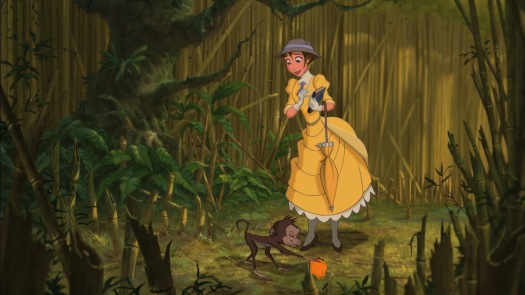
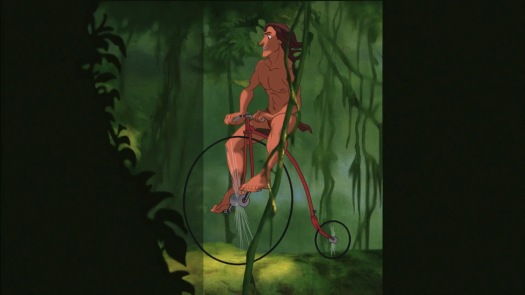

34. Tarzan
Date: c. 1880s (1882? 1890?)
Place: Nigeria (then British Nigeria)
There’s an unusual amount of evidence presented for the period in this film, mostly due to Strangers Like Me, where the characters can be seen using zoetropes, magic lantern projectors, orreries, phonographs and penny-farthings, among other things. The technology all dates the film to the late nineteenth century, and the comet the group observe through their telescope could be the Great Comet of 1882. The references to Kipling, Darwin and Victoria are a bit awkward, as Darwin died that year and Kipling was not yet well-known, but at least Victoria does make sense. Mind you, some of the slides Jane shows Tarzan depict things like the Statue of Liberty (1886), the Eiffel Tower (1889), cars (1886) and even planes (1903), but I suppose you have to draw the line at some point and simply dismiss certain things as anachronisms.
Fashion-wise, the bustles, petticoats and high collars Jane wears are all right for the time (although no practical woman in her right mind would wear a bustle on an expedition to the jungle), and she also has a lady’s pith helmet, a parasol and spats over her boots. Darken the yellow to khaki and drop the bustle, and her outfit is surprisingly accurate! A final clue is Clayton’s gun – it’s a boxlock double-barrelled shotgun, which were first introduced around 1875.
35. Make Mine Music (The Martins and the Coys)
Date: c. 1880s (UPDATE)
Place: West Virginia/Kentucky, USA
This segment was based on the real-life Hatfield-McCoy Feud, which spanned multiple generations across the late nineteenth century but was at its peak in this decade. Of course, Grace Martin isn’t dressed remotely appropriately for the time – honestly, it’s a bit scandalous even by 1940s standards – but this isn’t one of the more serious entries anyway.
UPDATE: Upon re-watching, I noticed that Grace and Henry use a hand-cranked car, which suggests a time nearer to the 1910s, or at least the 1890s.
(http://disney.wikia.com/wiki/File:41406.jpg, http://disney.wikia.com/wiki/File:Grace_Martin_%26_Henry_Coy.jpg – credit for the images)
36. Pinocchio
Date: 1883
Place: Friuli-Venezia Giulia, Italy
The original story was first published in this year, and the fashions roughly support this setting with the traditional lederhosen and Haferlschuh. Of course, the cuckoo clock is a widely-recognised symbol of the Black Forest region in Germany (this film was made right after Snow White), so to explain the Germanic flavour in spite of the Italian story, I’ve moved the location of Pinocchio’s town up to Friuli-Venezia Giulia near the border with Austria, a region with connections to both the Bavarian aesthetic and the coast (which is of course necessary for the Pleasure Island parts). Interestingly, the key influence on the design of the town was not Italian but German, the town of Rothenburg ob der Tauber in Bavaria.
37. The Jungle Book
Date: 1893
Place: Madhya Pradesh, India (during the British Raj)
This one suffers from the same problem as The Lion King; there’s an almost total absence of human culture to draw on, so the time period is anyone’s guess. We can at least be certain that it’s set in India thanks to the narration. I’m going back to the source material again for this one – that puts the jungle in the central province of Madhya Pradesh, and the time period is colonial so India would have been under British rule. The stories were first serialised beginning in 1893, so that’s as good a year as any to put the film in.

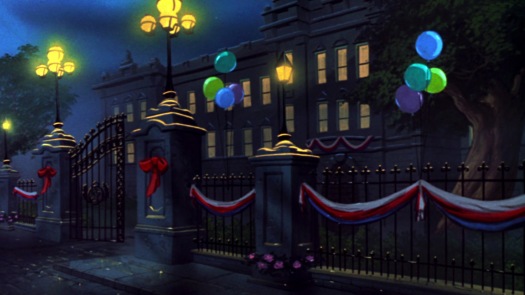
38. The Great Mouse Detective
Date: 1897
Place: London, England
This is one of those handy ones where the time and place are made explicit from the beginning, so that helps! Basil obviously borrows his deerstalker from the famed Sherlock (who first appeared in 1887), and Ratigan’s dramatic opera cloak and pocket watch would have been the height of fashion at the time. As the film notes, this was the Diamond Jubilee year of Queen Victoria, and apparently also the same for Queen Mousetoria (certainly worth celebrating; she’s outlived the average mouse by a good fifty-eight years!)
39. Peter Pan
Date: 1902
Place: London, England (and Neverland)
1902 was the date the first Pan novel was published (The Little White Bird), and the Edwardian fashions fit in with this nicely – top hats and opera cloaks for George Darling, Gibson girl hair and a narrower silhouette for Mary Darling, pin curls and a high-waisted nightgown for Wendy. Of course, like Alice in Wonderland, this is another film with only tenuous links to real history – much of the time is spent in the fictional Neverland (Captain Hook’s wardrobe comes straight out of the Golden Age of Piracy, centuries earlier, but he’s obviously from a different time).
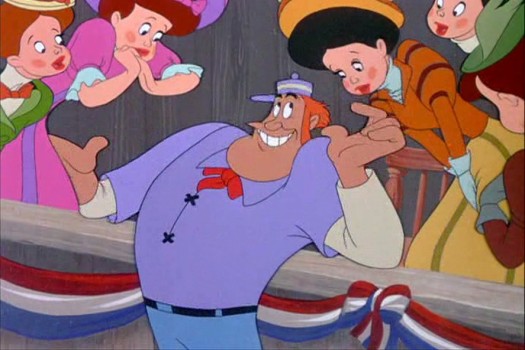
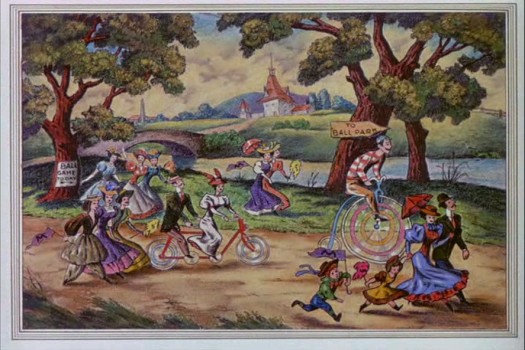
40. Make Mine Music (Casey at the Bat)
Date: 1902
Place: Holliston, Massachusetts OR Stockton, California, USA (disputed)
Helpfully, the date is stated right in the song (“He was the Sinatra of 1902!”) and the fashions of the women support this, but the location is up for debate. Two US towns laid claim as the inspiration for Mudville from the original Thayer poem – Holliston was close to Thayer’s childhood home, and Stockton actually used to be called Mudville. The latter even renamed its baseball team the “Mudville Nine” for the 1902 season!
41. The Adventures of Ichabod and Mr. Toad (Mr. Toad)
Date: 1909 to 1910
Place: London, England
The date came from online trivia and seems about right (the original story is from 1908); it takes place right around the turn of the new year, so we go from 1909 to 1910 over the course of the short. The fashions (Rat looks like a prototype for Basil) and the rising popularity of both the motorcar and the aeroplane all support this period, too, with both vehicles appearing of roughly the right style.


42. Lady and the Tramp
Date: 1909/1910
Place: St. Louis, Missouri (?), USA
Once again, I got the date online, and the fashions, telephones, horse-drawn buggies and gaslit streets all fit. The setting was apparently inspired by Walt’s boyhood home of Marceline in Missouri, but I thought that perhaps it could be set in St. Louis, since the town also draws on the style of Meet Me in St. Louis (1944).
43. Make Mine Music (Johnnie Fedora and Alice Bluebonnet)
Date: c. 1910s
Place: New York City, New York, USA
The fashions – particularly the hat styles – suggest this period, with the fedora growing in popularity from this time onwards. We also see ice being delivered by horse-drawn wagons in a time before refrigeration. Meanwhile, the references to the Brooklyn Bridge and the Jersey Shore all help to pinpoint the location.

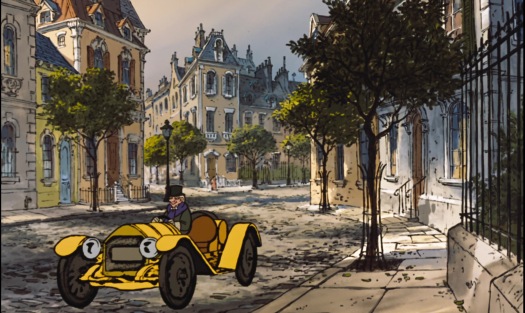
44. The Aristocats
Date: 1910
Place: Paris, France
Another film where the time and place are clearly stated. In my original review, I discussed the period in more detail: “We see a lot of old-fashioned hand-cranked cars and trucks, with some of them proving to be more accurate for the time period than others: on further investigation, I found out that the milk truck is modelled on a Ford Model BB from the early 1930s, while the removal truck at the end (which was lifted from Dalmatians) was from the Morris-Commercial FE Series from 1955. Georges’ car, on the other hand, looks like a more appropriate 1910 Mercer Model C Speedster – I love that he’s “modern” enough in his eighties or nineties to have made the transition from horses to cars, long before most other people had done so.
The Métro and the Eiffel Tower are also period-appropriate features of Paris (opening in 1900 and 1889, respectively), as is Edgar’s motorcycle, with the first mass-produced models appearing in 1894. On the other hand, the presence of modern-style traffic lights in the city at that time isn’t quite right; those were first introduced in Ohio in 1914. There is also a slight mistake in the label on the trunk which Edgar tries to lock the cats in, which lists Timbuktu as being part of “French Equatorial Africa”: the city at that time was actually a part of French West Africa, in the colony of Upper Senegal and Niger.”
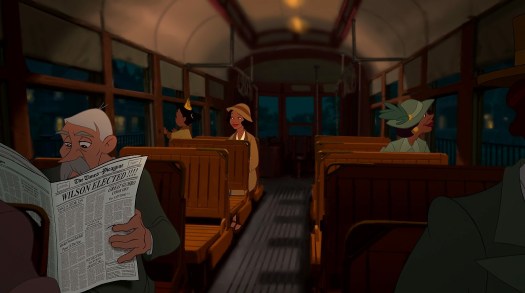
45. The Princess and the Frog (prologue)
Date: November, 1912
Place: New Orleans, Louisiana, USA
You have to have keen eyes to catch the dates in this film, but they are made clear if you look closely. In the prologue, the clue is hidden on a newspaper being read by a passenger on the cable car which Tiana and Eudora ride home; it is announcing Woodrow Wilson’s election (notably not his re-election in 1916). This would make the date November of 1912, and given Tiana’s official age of nineteen in 1926 later in the film, this seems about right – she looks and acts closer to five than nine in these early scenes.
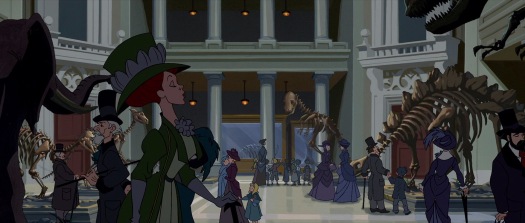
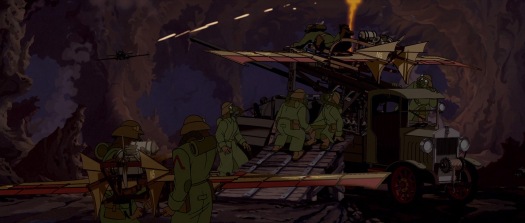
46. Atlantis: The Lost Empire
Date: 1914
Place: Washington, D.C. and Atlantis (Mediterranean/Santorini)
Another film with a specific date and location. We open in Washington, D.C., and see some women walking around in vaguely period-appropriate dresses (if a little dated); the year is even spelled out on-screen in old-fashioned typewriting-style font. The car Mr. Harcourt rides in and the fact that Milo’s grandfather wore a nineteenth-century pith helmet all suit the 1914 setting, too, but there are still some pretty glaring anachronisms.
My two biggest problems are Audrey and Helga – not only are their wardrobes grossly inaccurate for the Edwardian period (women in trousers and slinky evening gowns?), their very jobs seem unlikely at best. Prior to World War I, women had very limited roles in the military, so Helga being a lieutenant makes little sense. Audrey as a mechanic is slightly more plausible, especially since she was personally taught by her father, but it’s still a stretch considering she’s just eighteen (she also chews gum over a decade too early; it wasn’t invented until 1928). Also, Whitmore keeps an aquarium full of coelacanths, an ancient “living fossil” which was not first re-discovered until the 1930s, but given the nature of his work, it’s not impossible that he could have secretly found some himself a little earlier.
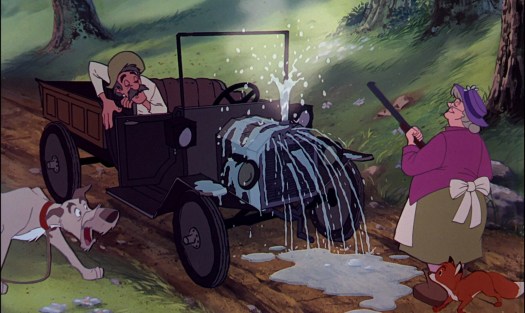
47. The Fox and the Hound
Date: c. 1920s
Place: Appalachia (Maine?), USA
A tough one, but there are a few clues to work with here. As GeekDad points out, “Amos’ car is a Model T Ford truck with hand-crank starter and kerosene lamp hung from rear as a tail-light (pre-1915), but his car is old; Widow Tweed’s car has electric starter (available by 1919, standard after 1923). Diesel trains became standard by 1935, with steam trains limited to historic displays.” The vehicles are our main clue, but there are also the vintage telegraph poles with ceramic insulators and cast iron cooking ranges. As for the location, the scenery and the presence of bears suggests its somewhere in the north-eastern Appalachian region of the USA.
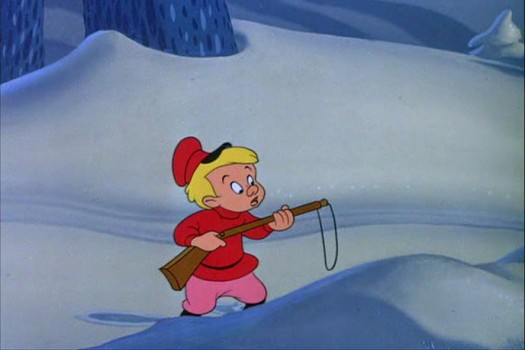
48. Make Mine Music (Peter and the Wolf)
Date: c. 1920s
Place: Russia (then part of the Soviet Union)
I picked the 1920s for this short because that was the decade that saw the founding of Lenin’s Pioneer movement, and the original composition from 1936 had Peter as a Young Pioneer. Given the American nature of the piece, it’s somewhat doubtful whether Peter is supposed to be one in this version, but it’s just about the only clue we have to the time period. The setting, at least, is obvious – it’s the only time Disney have visited Russia in one of their films (remember, Anastasia ain’t Disney).


49. The Princess and the Frog
Date: April, 1926
Place: New Orleans, Louisiana, USA
For the second time in this film, newspapers are our guide; the one announcing Naveen’s arrival sets the date as April of 1926, while another being read by Big Daddy La Bouff mentions the debut of the Ford Trimotor (first flew in June) and Gertrude Ederle swimming the English Channel (which she did in August). Mardi Gras also fell in February that year, but hey, getting the months wrong isn’t bad by Disney’s standards – at least it’s all correct for the year. Some of the fashions do support the period, but the dresses are generally a bit too form-fitting, and of course the huge princessy numbers are pure fantasy.
The film almost entirely ignores the uncomfortable reality of Jim Crow and segregation that was in force in New Orleans at the time, only alluding to it with a few veiled comments about Tiana’s “background” from the Fenner Bros., but I suppose it is a family film at the end of the day – they couldn’t be too explicit about the oppression being suffered by African-Americans like Tiana at the time. Also, how realistic is it that an unmarried black woman could purchase property in her own name at that time? Granted, the twenties were right in the middle of the golden age of black entrepreneurship and the National Negro Business League did exist, but as far as I can determine, only married women could own property in their own name until the Equal Credit Opportunity Act of 1974.
50. The Many Adventures of Winnie the Pooh
Date: 1928
Place: Ashdown Forest, Sussex, England
This is another film with few clues to the time period, but the setting is easy – the Hundred Acre Wood is widely known to have been based on Ashdown Forest in Sussex, England. I’ve chosen 1928 for the setting because the first two collections of Pooh stories came out between 1926-1928, and the old-fashioned tricycle in “Christopher Robin’s” bedroom matches the period. He’s also wearing Mary Jane-style shoes, which suggests a pre-1930s setting, as the shoes became associated more with girls after that.

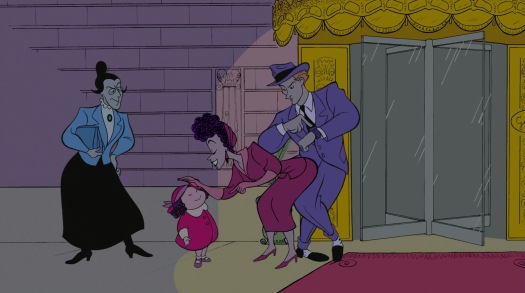
51. Fantasia 2000 (Rhapsody in Blue)
Date: c. 1930s
Place: New York City, New York, USA
This one is clearly set in Depression Era New York; a newspaper announces “JOBS SCARCE” and Jobless Joe is wearing a thirties-style trilby. Rachel’s nanny looks noticeably behind the times in her more Edwardian getup, and Duke’s passion for jazz and his job building skyscrapers point to this era as well (the Chrysler and Empire State went up in 1930 and 1931, respectively).
52. Dumbo
Date: 1941
Place: Florida, USA
Our location for this film is given on a colourful map near the beginning, and the date is the year of the film’s release – this is the canon’s oldest modern-set film. The sleek, up-to-date train carriage we see Dumbo’s mother riding in at the end is our main clue, but the date can also be made out on a newspaper near the end, and the popularity of circuses also suggests a 1940s setting, especially given the blatant disregard for animal welfare.
53. Saludos Amigos
Date: 1941
Place: Bolivia/Peru, Chile, Argentina and Brazil
The settings in this one are either shown on stylised maps, or can be deduced from the context. Lake Titicaca, for instance, lies on the border of Bolivia and Peru, and Pedro visits the Argentinian Mount Aconcagua from Chile, about fifteen kilometres away. For the date, I went with the year of the artists’ big trip to South America, since the live-action footage was shot then and there’s nothing to suggest it’s meant to be any earlier.
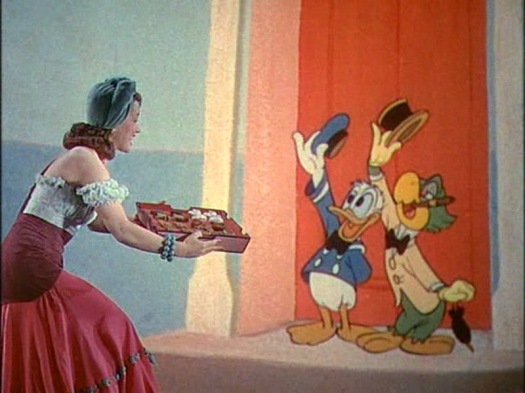
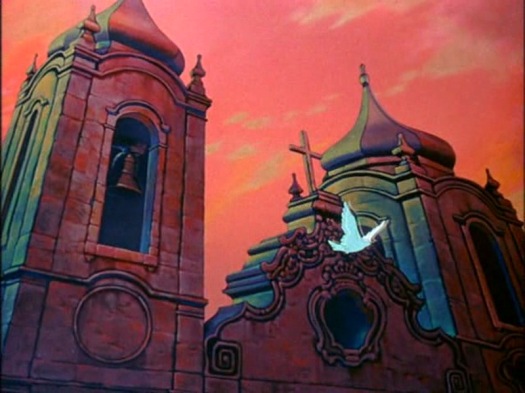
54. The Three Caballeros
Date: 1941
Place: Antarctica, Galápagos Islands of Ecuador, Argentina/Uruguay, Brazil and Mexico
Once again, I’ve used the date of the research trip; a lot of the music in this film is from 1941 specifically, so it’s set firmly in that year. The locations are mostly made clear, but The Flying Gauchito segment could be set in either Argentina or Uruguay (since Saludos Amigos already featured Goofy in Argentina, we might as well claim this short for Uruguay). These two films would be Disney’s only “visit” to the nations of South America until The Emperor’s New Groove, more than half a century later.
55. Bambi
Date: 1942
Place: California, USA
This nature-documentary-style film is similar to The Lion King in that it has very few visible signs of human presence. Given that, there’s nothing stopping us from assuming it’s contemporary; the popularity of hunting certainly seems to support an early 1940s date. As for the setting, the film turned Bambi from a roe deer into a mule deer, a species commonly found west of the Rockies; the devastating wildfire that breaks out in the climax is further evidence that we’re in California.
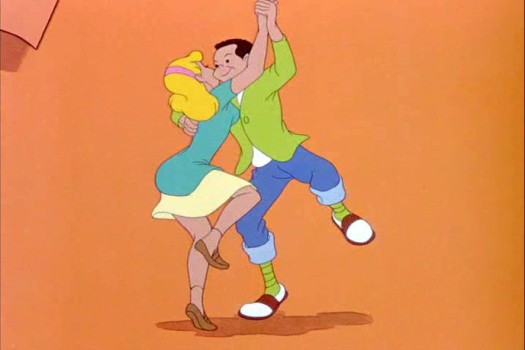
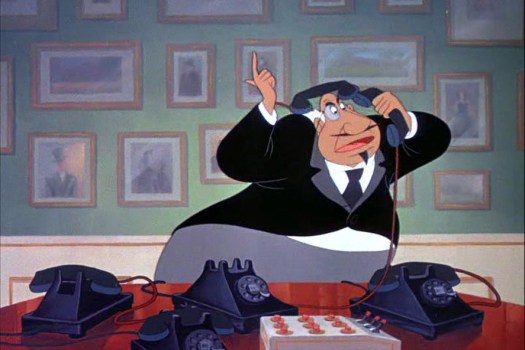
56. Make Mine Music (All the Cats Join In and The Whale Who Wanted to Sing at the Met)
Date: 1946
Place: USA
The first of these segments is a clear snapshot of America (or at least, the artists’ perception of it) in the mid-1940s. The style of music, the slang, the dancing, the clothes, the jukebox, the “malted shop” – everything screams forties. It’s a fun short to watch from a modern perspective, although I doubt real “teen-agers” of the time were as innocent as they seem here!
For the second, the fashions (old-fashioned black tie and monocles) support this period, as does the higher popularity of opera music (at least compared to today), the decline of the American whaling industry and the style of telephones and cameras.
57. Fun and Fancy Free
Date: 1947
Place: Western USA (and Happy Valley)
The Bongo and live-action segments are all definitely contemporary, with another circus-themed story and all the live-action actors dressed in 1940s styles. Mickey and the Beanstalk is framed as a fairy tale being told by characters in the present day, so I’m not going to try and work out when it’s supposed to be (although the hose-and-tunic style suggests a vaguely medieval time). Don’t even get me started on the horrendous ventriloquism… Bergen himself didn’t even like it.

58. Melody Time (Little Toot)
Date: 1948
Place: New York City, New York, USA
Presumably this is a modern-set short, judging from the style of the ships and the skyscraper-laden city on shore.
59. One Hundred and One Dalmatians
Date: November, 1958
Place: In and around London, England
Most people automatically assume this is 1961 because the film is clearly contemporary (they have televisions and nobody drives horse-and-carts anymore), but once again, a newspaper allows us to be more specific. The one read by Cruella after the puppies are stolen tells us (if you look very closely) that it is actually late 1958. This hardly makes a difference; the elements presented still fit nicely with that date. Anita’s “new spring suit” and Cruella’s fur coat, probably made from mink or fox (ugh), are both fashionably accurate. Among the TV shows we see, there’s a crime-based parody of What’s My Line? (1950-1967), a parody of Lassie (1954-1974) and The Adventures of Champion (1955-1956). The removal truck used in the final chase is also a Morris-Commercial FE from the late 1950s, although Cruella is driving a fairly dated car based on various models from the 1930s.
60. The Rescuers
Date: 1977
Place: New York City and Louisiana, USA
This one is another contemporary entry. Medusa’s rather shapeless halter-neck dress and boots are about right for the time (although who knows where they got that dramatic hair flip from), as are Penny’s pinafore, tights and Mary Janes. Snoops also wears a rather fetching pair of Cuban Heels with his suit – methinks he’s a disco fan! Outside of the fashions, the presence of modern helicopters also hints at the date, and Medusa is seen using a rotary-dial phone, which would not begin to be phased out by push-button ones until the next decade at least.
61. Oliver & Company
Date: 1988
Place: New York City, New York, USA
As Chandler might say… could this film be any more eighties? Wrestling, Jane Fonda-style exercise tapes, sweatbands, boom boxes, TIME Magazine, a grungy-looking pre-Giuliani New York, product placement and advertising… Yes, this one is thoroughly and explicitly contemporary. On a sadder note, the presence of the Twin Towers also makes it bluntly clear that this is a pre-2001 world.
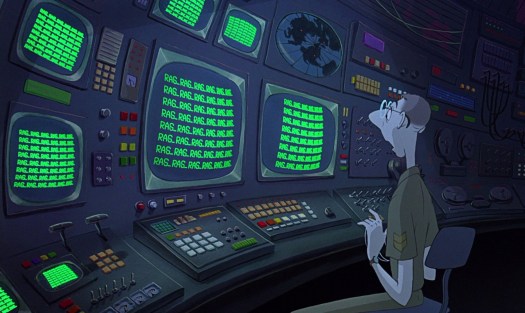
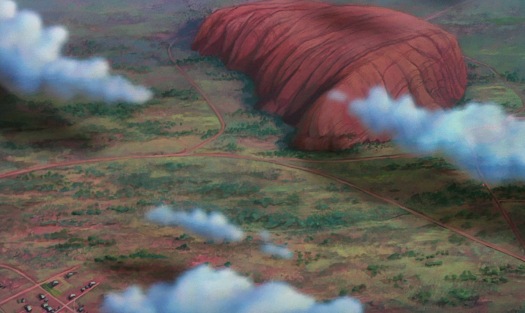 62. The Rescuers Down Under
62. The Rescuers Down Under
Date: 1990
Place: New York City, USA and Northern Territory, Australia
There are two key aspects which tell us that this sequel is set some time after the 1977 original. First off is the technology – the computers we see in the message-relay sequence use monochrome monitors, popular through the 1980s and still widely used into the early 1990s. Then there’s the strong undercurrent of environmentalism running through the whole “anti-poaching” plot; FernGully would deliver this message even more overtly two years later. The Marshall Islands are also prominently featured during the relay sequence, possibly due to them recently gaining independence from the US in 1986. Of course, they kind of missed the boat on the whole American fascination with Australia – that was carried over from the Crocodile Dundee days of the 1980s.
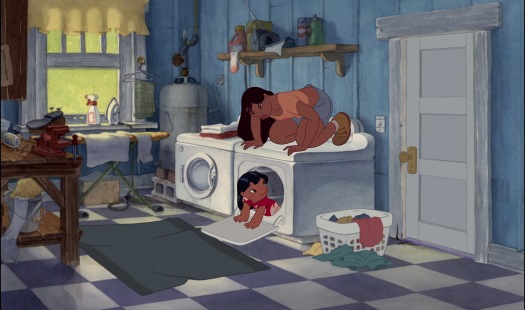

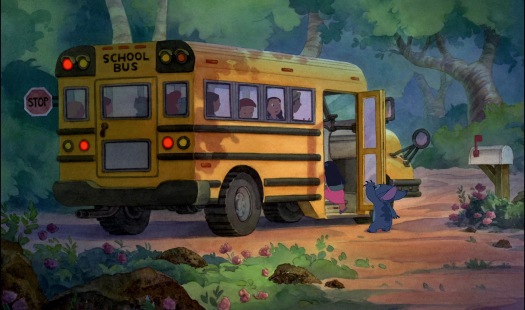
63. Lilo & Stitch
Date: 2002
Place: Outer Space and Kauai, Hawaii, USA
The film basks in its setting; it’s gloriously Hawaiian. Specifically, we see a map that clearly states Lilo lives on Kauai – a fact supported by the presence of the Kilauea Lighthouse and red fire trucks (most other Hawaiian ones are yellow). The main inspiration for Lilo’s town was Hanapepe, and some remarkably specific details seen in person by the artists can be found in the scenery.
We’re definitely in modern times, too – Lilo has a fascination with the American tourists who come to the islands, which by 2002 had long been a state, and a deleted scene underlines her frustration with being seen as a commodity in her own country, a very contemporary Hawaiian problem. The blenders, cordless phones, refrigerators and washing machines all add to the modern atmosphere, but what’s interesting is that Lilo has a fascination with the past. She listens to music on a record player rather than an iPod, and she dresses in traditional Hawaiian muumuus rather than the more Western shorts and tee-shirts worn by her sister and schoolmates. It’s a subtle way of showing her pride in her own culture and her confidence in expressing her individuality, just one of the many reasons I love her as a character.
64. Chicken Little
Date: 2005
Place: Alternate USA
A generically midwestern American-style town (“Oakey Oaks”) populated by animals, but apparently living in some sort of strange alternate version of the modern timeline. The characters have cell phones and email technology, and they exist in a world where the 1970s, 1980s and 1990s have already happened (judging from the presence of disco music, Raiders of the Lost Ark and a Spice Girls song).
65. Meet the Robinsons (Lewis’s timeline)
Date: 2007
Place: USA
Another generically American-style setting, but the dates are more specific. According to the directors, the official date of the “future” scenes is 2037, putting the rest of the film in the contemporary time of 2007 and Lewis’s flashbacks to the night his mother left him at the orphanage in 1995. It’s a good thing the directors gave us this information, because the “technology” on display is far too wacky and cartoonish to help us tie the film down to any real chronological point.
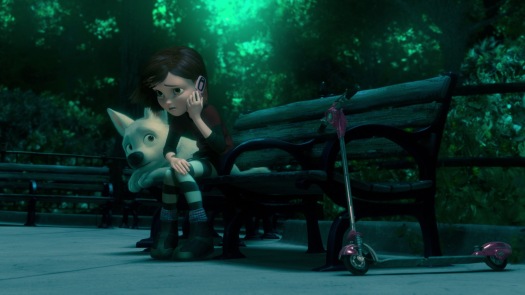
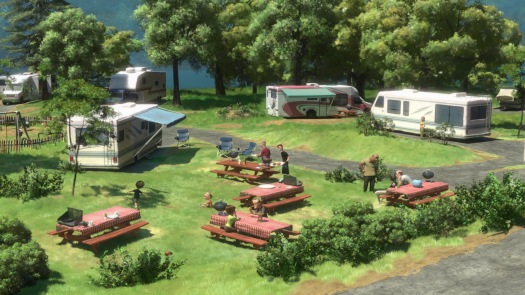
66. Bolt
Date: 2008
Place: New York City, Los Angeles, Las Vegas and Ohio, USA
Maps are featured throughout this film, showing us the various states that the gang pass through on their Homeward Bound-style journey from New York to Los Angeles. The setting is clearly modern, with a heavy emphasis on television shows and production and some subtle commentary on the wastefulness of modern society. Penny’s tights-under-shorts look is also very of-the-time; I remember it. I was there. (Shudder).
67. Winnie the Pooh
Date: 2011
Place: Ashdown Forest, Sussex, England
As always, our only link to the human world in this Pooh film is Christopher Robin; his outfit has been updated to a modern school uniform (complete with untucked shirt), suggesting that it is no longer 1977 but 2011. Although this is considered a “sequel,” the rules of the Pooh universe have always been pretty flexible, so it’s clear that this is a different version of Christopher unique to this film, not the forty-year-old man that the original one would have been by this point.
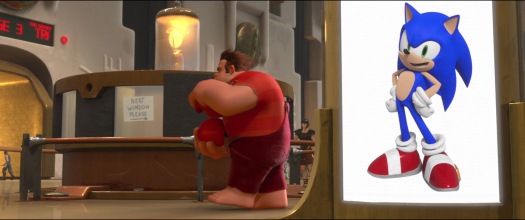
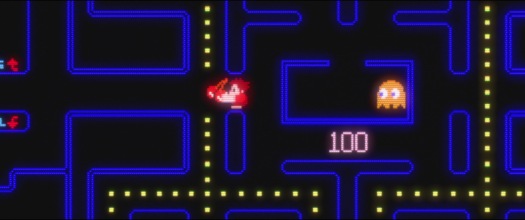
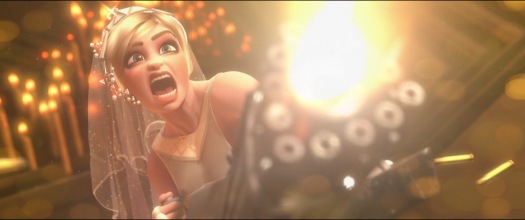
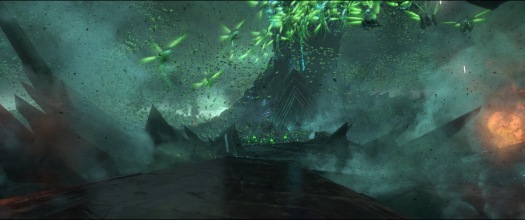
68. Wreck-It Ralph
Date: 2012
Place: USA
The many video-game references anchor this one firmly in time – we’re post-Sonic, post-Mario, and post-Call of Duty. Ralph’s game is based on the typical 8-bit games of the early 1980s, and the other characters from it throw a thirtieth anniversary party at the start of the film. Simple! As for the place, it’s natural to assume it’s somewhere in America; the glimpse we get of the arcade shows it beside an American-style overpass with green road signs, and you can make out a billboard with Mickey Mouse on it in the background too.
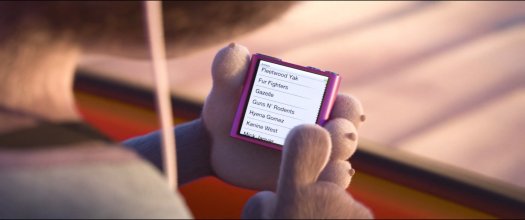
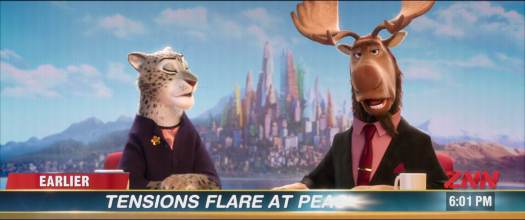
69. Zootopia / Zootropolis
Date: 2016
Place: Alternate USA
Similar to Chicken Little, this gives us another alternate animal-version of modern America, with Judy moving from her generic small-town backwater to a sprawling metropolis in order to “make it” in her dream job. The political drama about race relations and drug abuse (subtext, I know) make it clear that this is a very contemporary setting with a very contemporary message. Judy is also seen using modern technology like video chat, cell phones, surveillance cameras and an iPod (or something like one), and Nick notes at one point that using CDs is considered old-fashioned.

70. Ralph Breaks the Internet: Wreck-It Ralph 2
Date: 2018 (presumably)
Place: USA and the Internet
I know this one hasn’t been released yet, but from what we’ve seen in the trailers and given that it’s a sequel to a modern-set film, it’s almost certain that this one will be set in the present too. Notably, the film is going to feature the website http://www.ohmy.disney.com, which was launched in early 2013.
By Source, Fair use, https://en.wikipedia.org/w/index.php?curid=53627514 – credit for poster
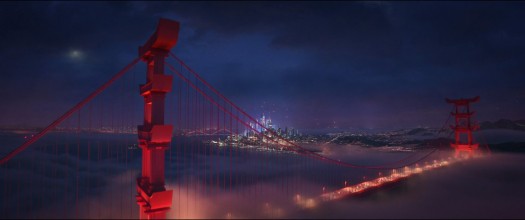
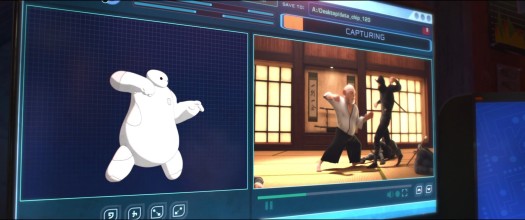
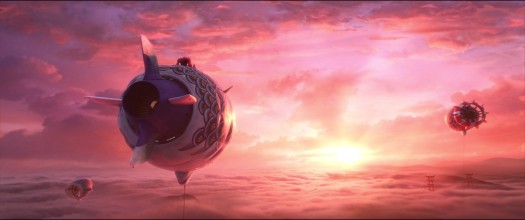
71. Big Hero 6
Date: 2032
Place: San Fransokyo, USA (fictionalised version of San Francisco combined with Tokyo)
One of Disney’s rare forays into the future, the date has been confirmed by the directors as being 2032. That means fourteen-year-old Hiro was probably born this year! Much of the technology seen in the film, like plasma cutting and Maglev, is actually in use today, while robots like Baymax and the microbots are in development and could be a reality in a few more decades. The animators researched these elements in detail at the Carnegie Mellon University, so it feels far more authentic than the stuff we see in Meet the Robinsons. The city of San Fransokyo uses aerostat wind turbines to generate power in a more environmentally-friendly way (these already exist) and the blend of American and Asian aesthetics, while explained by the directors as being due to an alternate timeline in which Japan won WWII (okay…), could also reflect the rising interest from young Americans in the cultures of Asian nations like South Korea and Japan. The economies of countries like these, along with India and China, are set to become the new superpowers later in this century, so cities like San Fransokyo may one day become a reality as well.

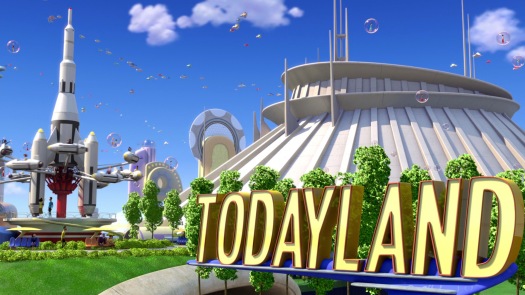
72. Meet the Robinsons (Wilbur’s timeline)
Date: 2037
Place: USA
As mentioned above, this is the date given by the directors for the “future” portions of this film (i.e., Wilbur’s time). It’s so cartoony that there’s little to realistically suggest this time, although the idea of robots being considered family members might become a reality down the line as their role in society grows. Unfortunately, time travel (at least to the past) will probably never be a real thing due to the complex physical paradoxes it poses, so there’ll be no Tyrannosauruses trampling anyone’s lawns!



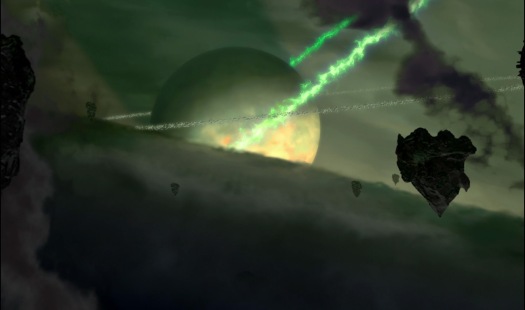
73. Treasure Planet
Date: Unknown; alternate future
Place: Alternate universe
Here we are at the very top of the list with Treasure Planet, a wondrous fantasy which completely embraces its fictional world. The steampunk aesthetic incorporates a lot of nineteenth-century fashion and design elements, but the futuristic gizmos and robots all point to a date far, far into the future. It’s impossible to say how long it could be before the creation of a breathable atmosphere for outer space might be a possibility, but we can only dream…
What a rollercoaster! I hope you’ve enjoyed this walk through Disney history – I had a great time researching it and really learned a lot. Some of the films did cause a bit of trouble due to the many anachronisms, but it’s still a fun experiment to undertake if you’re as big of a Disney nerd as me. This post marks the end of my Disney canon retrospective series: we’ve ranked them, celebrated the best and worst aspects of them, admired the art and tested our mettle in a quiz, but with this I think it’s time to close the book on this fascinating chapter of animation history (at least for now) and move on to other things. My next post will be my first thoughts on The Incredibles 2, and should be going up next week; I’m on holiday, so I won’t be able to reply to any comments until I get back. See you again soon!
References
In addition to liberal use of Google/Wikipedia, I consulted many web sources for this article:
http://disneysnewgroove.tumblr.com/post/96002007962/disney-movies-in-order-of-historical-setting – This was a valuable source for the dates
https://d-princesses.livejournal.com/1104677.html – As was this!
https://geekdad.com/2015/08/disney-movie-happen/ – and this! Lots of other people have been interested in attempting this timeline, apparently
https://www.deviantart.com/theantilove/art/Disney-Map-207593214 – And this was equally useful for locations
https://www.deviantart.com/shoomlah/gallery/29648049/Historical-Princesses – This explores the costumes of the films, reimagining them in a more historically accurate way
https://www.deviantart.com/wickfield – and so does this!
http://atlantisthelostempire.wikia.com/wiki/Atlantis:_The_Lost_Empire_Wiki – I used this to work out the rough date of the prologue of Atlantis
https://en.wikipedia.org/wiki/Genesis_flood_narrative#Historicity – a discussion of the Biblical Flood
http://www.knowa.com/article/696/flags_of_the_united_states_flag_of_great_britain_1606/ – a source about the Union Jack’s adoption in 1606
https://www.shmoop.com/hunchback-of-notre-dame/setting.html – This explores the date of Hunchback
https://dettoldisney.wordpress.com/2011/11/18/mulan-vs-the-legend-of-hua-mulan/ – This one is good for the details of Mulan
https://texasalmanac.com/topics/agriculture/cattle-drives-started-earnest-after-civil-war – a history of cattle drives in Texas; handy for Home on the Range
http://findingcorona.tumblr.com/fashion – Fashion in Tangled
https://www.theguardian.com/film/2012/aug/29/scottish-historian-view-brave – a short critique of Brave
http://screenprism.com/insights/article/does-any-technology-like-that-seen-in-big-hero-6-actually-exist – a discussion of the futuristic technology in Big Hero 6
http://www.pnas.org/content/108/5/1815.full – a very technical paper about Polynesian expansion which helped me to decide on Moana’s setting

















































































Ooh, this was fun!
The Lion King’s date was definitely interesting!
LikeLiked by 1 person
There was simply no other clue to when it might be, so I used Scar’s “cameo” haha
LikeLiked by 1 person
Quite interesting, although your placement of HOME ON THE RANGE in the year 1870 is complicated by the fact that the deed to Patch of Heaven that Slim almost signs is dated 1889*, seven years after the Chinese Exclusion Act was passed into law. (Incidentally, I just recently watched a documentary about that miscarriage of justice as part of the “American Experience” series on PBS.)
LikeLiked by 1 person
Ah, well spotted! When using dates from newspapers/documents in the other films, I usually got the dates out of trivia sections from people who’d seen the screenshots more closely (I haven’t got the best eyesight). Apparently for that one nobody cared enough to make a note, so I didn’t realise the date was in the film! Either way, it clashes with the Exclusion Act detail, so I’ll just make a little note rather than re-order the whole list.
LikeLike
Another nice entry! I’d like to add two fauna inconsistensies: Snow White’s story may take place in Germany, she’s surrounded by North American animals like grey squirrels, chipmunks, new world quails, and raccoons… Likewise, ‘Jungle Book’ is set in India, but King Louie is an Orangutan, a species that only occurs on the isles of Sumatra and Borneo (Indonesia)…
LikeLiked by 1 person
Thanks, glad you enjoyed it! Ah yes haha, much as I love the little tortoise and his friends, they definitely don’t belong in Germany. I think that the Americanised fauna in that one can just be dismissed as the animators wanting to include familiar faces for their American audience.
As for Louie, my theory is that he is perhaps an escaped import, the exotic pet of some careless Maharaja – that would explain why Louie is so fascinated by humans and knows a bit about their ways!
LikeLiked by 1 person
Nice research. One small note. I was part of the original story team on Beauty and the Beast. We set it in the year 1708-1720, in the Loire area of France. The costumes did not always reflect that due to the American artists, but that was the intent.
LikeLiked by 1 person
Oh my goodness! This has really made my day, thank you so much for reading! I put a lot of work into this, so it’s great to have your feedback.
What a treat to hear from a member of the original story team on such a terrific film! I didn’t realise it was set so early; I’ll add a note to clarify that part.
I hope you’ll visit again some time – I’m always eager to learn more about the Disney classics. Thanks again!
LikeLike
Hi there, just discovered your website upon a random search. I look forward to reading more 🙂 You were surprisingly very thorough with this timeline which I appreciate and it was pretty insightful too. I actually wanted to point out though that San Fransokyo isn’t the result of the Japanese winning WWII, but a rebuilding of the city after the 1906 earthquake; the Japanese immigrants helped the locals rebuild. This has been confirmed by art director Scott Watanabe. Keep up the good work!
LikeLiked by 1 person
Welcome, and thanks for reading! 🙂 We’ve got lots of film reviews coming up, so there’s plenty to look forward to.
Ah yes, I found that out after this article went up, my mistake. I think I might have been remembering some kind of early pre-production idea or something; the backstory about the earthquake does make more sense.
LikeLike
One minor note about The Fox And The Hound, railroads used steam engines well into the 1950s with most completing the transition by 1955. The Appalachia based Norfolk and Western though built its last steam engine in 1953 and retired its steamers in 1960. Diesels in 1935 were low power experimental units, good for slow speed industrial operations or very short passenger trains. By 1940 the technology had advanced well enough that the first practical high speed heavy locomotives were possible but production disruptions due to the Second World War meant that only a few were built during the war. I would suggest looking at the Wikipedia article for the EMD FT for the pioneering diesel locomotive overview, as well as the historical pages for various railroads around the country.
LikeLiked by 1 person
Very informative, thank you! I think my source for that section may have been slightly early with his dates, although it doesn’t affect the time that Fox and the Hound seems to be set in. You’re right, the Wiki article on dieselisation makes it clear that the transition only began in the 20s-30s, and didn’t really get going until the 50s.
LikeLike